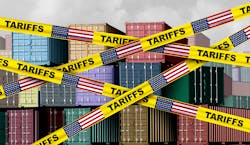Tariffs Could Add Billions in New Costs for Midsize Firms
Full universal tariffs could add up to $187.7 billion in direct import costs, more than six times the cost of earlier tariffs in place at the start of 2025, says JPMorganChase report.
Midsize businesses are overexposed to potential high-tariff countries, with the wholesale and retail sectors having the highest exposure, according to a new report from JPMorganChase. These sectors rely more heavily on imports countries facing the highest rates—21% of their imports come from China, which is now subject to a 55% tariff.
This report finds that midsize businesses are disproportionately exposed to tariff hikes because they rely more heavily on imports from countries facing the highest rates—21% of their imports come from China, which is now subject to a 55% tariff. Among midsize firms, the wholesale and retail trade sectors have the highest direct exposure. Many of these operate on thin margins, so even small cost increases can lead to higher prices for customers or disruptions across local supply chains.
The implementation of full universal tariffs announced on April 2nd could add up to $187.7 billion in direct import costs for midsize firms—more than six times the cost of earlier tariffs in place at the start of 2025, the report noted.
Even with some tariff reductions announced, the current policy still leaves midsize firms facing $82.3 billion in costs.
Major trade hubs such as Southern California, Texas, and the Northeast will experience the steepest impact.
The report offers the following conclusions ( excerpted below)
Rapid policy developments increase the importance of monitoring several data sources. Since the start of 2025, trade policy has often evolved quickly, with many tariffs being announced, implemented, and in some cases delayed on short notice. Since official economic data is often released with a significant lag, alternative data sources may be helpful in spotting early signs of any effects on trade activity and financial health of midsize firms.
Robustness of supply chains is crucial. Our analysis reveals that a significant share of midsize firms exposed to tariffs operate in industries that produce intermediate goods as part of larger supply chains. For those firms, the tariffs may provide an opportunity to strengthen their position as domestic suppliers, provided that the benefits are not outweighed by the higher cost of imported inputs. If one firm cannot deliver intermediate goods, it may have ripple effects to other firms within the same supply chain. Policymakers should consider this when evaluating how tariffs might affect firms.
Business leaders should plan for a range of outcomes. The tariff rates that have been announced so far have varied widely from one country to the next, and we have seen that policy can shift quickly. For these reasons, it can be risky for businesses to rely heavily on imports from one country without an available alternative. Business leaders may want to plan for multiple contingencies and identify possible substitutes for essential imported inputs early on, in cases where this is possible.
Most affected sectors operate on thin margins. Wholesale and retail trade are the most tariff-exposed industries, and these firms often do not have much scope to lower their margins. Therefore, there is a risk that a significant share of costs will be passed on to other firms and to end consumers. This could be particularly painful for the lowest-income households, who are the most sensitive to rising retail prices (Minneapolis Federal Reserve 2024). Policies that support the purchasing power of these households in the face of inflation could both be helpful to the households themselves and help support continued U.S. growth.
